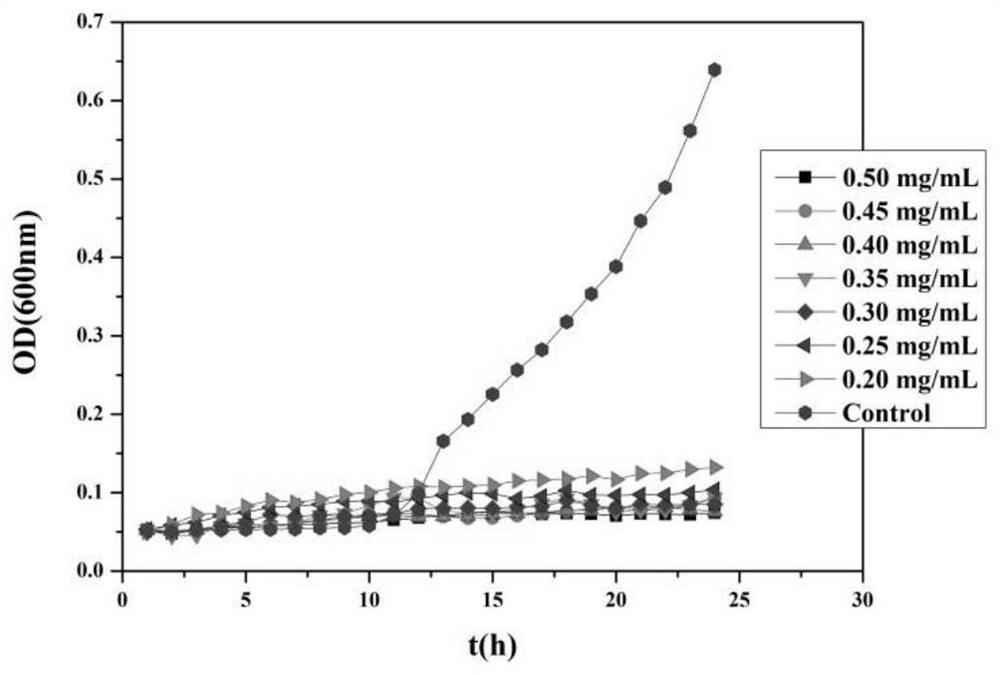Preparation method of cobalt-doped zinc oxide/molybdenum disulfide nano composite antibacterial agent
A technology of molybdenum disulfide and nanocomposite, applied in botany equipment and methods, fungicides, biocides, etc., can solve the problems of electron-hole recombination, poor biocompatibility, easy aggregation, etc., and achieve broad-spectrum antibacterial Strong antibacterial activity, high biocompatibility
- Summary
- Abstract
- Description
- Claims
- Application Information
AI Technical Summary
Problems solved by technology
Method used
Image
Examples
Embodiment 1
[0028] Step 1: Weigh 0.3g of sodium molybdate and 0.6g of L-cysteine and disperse them in 50mL of deionized water, and stir for 30min until they are evenly dispersed. Put the uniformly dispersed solution into an ultrasonic cell pulverizer (400w) for ultrasonic treatment for 20 minutes, then take out the solution and pour it into a polytetrafluoroethylene lining, and put it into a reaction kettle. Subsequently, the reactor was put into an oven to react at a temperature of 180° C. for 30 h. Finally, centrifuge, wash, and purify to obtain molybdenum disulfide nanosheets.
[0029] Step 2: Weigh zinc acetate dihydrate and cobalt acetate tetrahydrate respectively according to the molar ratio of zinc and cobalt as 1:0.007 and disperse them in absolute ethanol. After stirring evenly, the mass ratio of molybdenum disulfide nanosheets to zinc acetate dihydrate Add molybdenum disulfide nanosheets at a ratio of 0.03:1, heat and react in a water bath at 80°C for 2 hours to obtain a mixe...
Embodiment 2
[0033] Step 1: Weigh 0.3g of sodium molybdate and 0.6g of L-cysteine and disperse them in 50mL of deionized water, and stir for 30min until they are evenly dispersed. Put the uniformly dispersed solution into an ultrasonic cell pulverizer (400w) for ultrasonic treatment for 20 minutes, then take out the solution and pour it into a polytetrafluoroethylene lining, and put it into a reaction kettle. Subsequently, the reactor was put into an oven to react at a temperature of 180° C. for 30 h. Finally, centrifuge, wash, and purify to obtain molybdenum disulfide nanosheets.
[0034] Step 2: Weigh zinc acetate dihydrate and cobalt acetate tetrahydrate respectively according to the molar ratio of zinc and cobalt as 1:0.007 and disperse them in absolute ethanol. After stirring evenly, the mass ratio of molybdenum disulfide nanosheets to zinc acetate dihydrate Add molybdenum disulfide nanosheets at a ratio of 0.025:1, heat and react in a water bath at 80°C for 2 hours to obtain a mix...
Embodiment 3
[0037] Step 1: Weigh 0.3g of sodium molybdate and 0.6g of L-cysteine and disperse them in 50mL of deionized water, and stir for 30min until they are evenly dispersed. Put the uniformly dispersed solution into an ultrasonic cell pulverizer (400w) for ultrasonic treatment for 20 minutes, then take out the solution and pour it into a polytetrafluoroethylene lining, and put it into a reaction kettle. Subsequently, the reactor was put into an oven to react at a temperature of 180° C. for 30 h. Finally, centrifuge, wash, and purify to obtain molybdenum disulfide nanosheets.
[0038] Step 2: Weigh zinc acetate dihydrate and cobalt acetate tetrahydrate respectively according to the molar ratio of zinc and cobalt as 1:0.007 and disperse them in absolute ethanol. After stirring evenly, the mass ratio of molybdenum disulfide nanosheets to zinc acetate dihydrate Add molybdenum disulfide nanosheets at a ratio of 0.02:1, heat and react in a water bath at 80°C for 2 hours to obtain a mixe...
PUM
 Login to View More
Login to View More Abstract
Description
Claims
Application Information
 Login to View More
Login to View More - R&D
- Intellectual Property
- Life Sciences
- Materials
- Tech Scout
- Unparalleled Data Quality
- Higher Quality Content
- 60% Fewer Hallucinations
Browse by: Latest US Patents, China's latest patents, Technical Efficacy Thesaurus, Application Domain, Technology Topic, Popular Technical Reports.
© 2025 PatSnap. All rights reserved.Legal|Privacy policy|Modern Slavery Act Transparency Statement|Sitemap|About US| Contact US: help@patsnap.com



